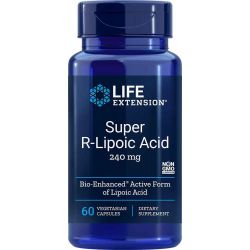Lipoic Acid
 Given the rising epidemic of diabetes and its devastating complications, natural strategies that support healthy blood sugar (glucose) and protect against oxidative stress offer hope for many individuals.
Given the rising epidemic of diabetes and its devastating complications, natural strategies that support healthy blood sugar (glucose) and protect against oxidative stress offer hope for many individuals.
Metabolic syndrome—a combination of risk factors such as insulin resistance, high blood pressure, high triglycerides, and low high-density lipoprotein (HDL)—increases one’s risk for diabetes and cardiovascular disease.
Widely known as a potent and effective antioxidant, lipoic acid demonstrates a multitude of unique properties. Regulated as a drug in several European countries (where it is approved for the treatment of diabetes-related complications, certain complications of alcoholism, and a variety of liver conditions),1,2 lipoic acid is an important component of every informed individual’s health maintenance regime.
In emerging research, lipoic acid has shown impressive benefits in the context of glaucoma, migraine, stroke, as well as bone health.
Protection Against Oxidative Stress
One of the underlying problems in diabetes is oxidative stress and the production of free radicals. These free radicals circulate in the body, attacking and damaging tissues. Since people with diabetes have high glucose levels, they are more prone to oxidative stress, which may contribute to the long-term complications of the disease.
Antioxidants such as lipoic acid prevent this damage by neutralizing free radicals and reducing oxidative stress.3,4 Lipoic acid is an unusual antioxidant because it can act in both water-soluble and fat-soluble domains in cells and tissues. Thanks to these  qualities, it is easily absorbed and transported into many organs and systems within the body, for example, the brain, liver, and nerves. Contrast this with antioxidants such as vitamin C, which is not very lipid-soluble (so is not able to penetrate the lipid wall of cell membranes very well), or vitamin E, which is not very water-soluble. When lipoic acid is combined with these antioxidants, the body’s ability to fight free radicals is greatly increased. In fact, lipoic acid helps to regenerate vitamins C and E.2
qualities, it is easily absorbed and transported into many organs and systems within the body, for example, the brain, liver, and nerves. Contrast this with antioxidants such as vitamin C, which is not very lipid-soluble (so is not able to penetrate the lipid wall of cell membranes very well), or vitamin E, which is not very water-soluble. When lipoic acid is combined with these antioxidants, the body’s ability to fight free radicals is greatly increased. In fact, lipoic acid helps to regenerate vitamins C and E.2
Furthermore, lipoic acid helps amplify the positive effects of other important antioxidants in the body such as glutathione and coenzyme Q10—two essential compounds in the fight against aging and disease.5 It also teams with the B-vitamin family to support energy production in the body by converting the components of food, namely carbohydrates, proteins, and fats, into stored energy for future use. Lipoic acid does this by helping to protect mitochondria, the energy-producing factories of cells, from being damaged by oxidative stress, thus ensuring that energy production in the body remains efficient.1
Metabolic Syndrome and Diabetes
Overwhelming evidence now suggests that lipoic acid may be critical for not only maintaining optimal blood sugar levels by helping the body to use glucose, but also for supporting insulin sensitivity and key aspects of cardiovascular health, such as endothelial function.
According to a just-released review of experimental studies, lipoic acid can help relieve several components of metabolic syndrome—a constellation of risk factors that often precedes full-blown types 2 diabetes. This review revealed that lipoic acid reduces blood pressure and insulin resistance, improves the lipid profile, and reduces weight. Scientists are encouraged by lipoic acid’s potential as a therapeutic agent for individuals with metabolic syndrome.6
Furthermore, another recent study of 36 patients with coronary artery disease found that a combination of lipoic acid with acetyl-L-carnitine reduced blood pressure and improved endothelial function of the brachial artery.7 This nutrient pair may therefore be an effective strategy for supporting healthy blood pressure levels, particularly in the  context of metabolic syndrome.
context of metabolic syndrome.
Just last year, investigators revealed dramatic effects of administering lipoic acid in improving insulin sensitivity in overweight adults suffering from type 2 diabetes. Lipoic acid produced significant improvements in a very short time frame—only four weeks of supplementation.8 This finding could have important implications, as insulin resistance lies at the heart of type 2 diabetes.
Even after complications of diabetes have manifested, lipoic acid offers help. It has been found effective in the treatment of diabetic neuropathy, a type of nerve damage that occurs as a result of the toxic effects of high glucose levels on the nervous system in diabetes. Diabetic neuropathy is characterized by numbness, tingling, and pain best described as “burning” in the extremities.9
A large, randomized, placebo-controlled, multicenter, double-blind study involving 328 patients with type 2 diabetes revealed that lipoic acid significantly improved symptoms of diabetic neuropathy, including sensations of burning, tingling, itching, and pain.9 Although this early study was carried out using intravenous infusions of lipoic acid, later research has shown oral lipoic acid supplements to also be effective. Just five weeks of oral supplementation with lipoic acid significantly improved the stabbing pain, burning pain, and numbness of the feet in patients suffering from diabetic neuropathy, with the dose-effectiveness range being 600-1,800 mg of lipoic acid dosed orally per day.10 The dose of R-lipoic acid to achieve this effect in diabetics would be half this amount, since it is the “R” form of lipoic acid that is biologically active in the body.
Promoting Better Eye Health
Lipoic acid offers promise in supporting optimal visual health.
 As adults grow older, they become more vulnerable to developing cataracts, opacities of the lens that cloud sight. A key problem involved in cataract formation is oxidative stress in the lens of the eye. Lipoic acid was found to offer notable protection against cataract formation in an experimental animal model. Scientists believe that lipoic acid may confer this benefit by increasing levels of essential endogenous antioxidant enzymes such as glutathione peroxidase.11
As adults grow older, they become more vulnerable to developing cataracts, opacities of the lens that cloud sight. A key problem involved in cataract formation is oxidative stress in the lens of the eye. Lipoic acid was found to offer notable protection against cataract formation in an experimental animal model. Scientists believe that lipoic acid may confer this benefit by increasing levels of essential endogenous antioxidant enzymes such as glutathione peroxidase.11
Another common cause of vision loss is glaucoma. A study in patients with open-angle glaucoma found that visual function and other measures of glaucoma were improved in a group that received either 75 mg of lipoic acid daily for two months or 150 mg of lipoic acid daily for one month, compared with a control group that received no lipoic acid.12
Furthermore, a recent study revealed that the combination of lipoic acid and vitamin E helped prevent retinal cell death in animals with retinitis pigmentosa, an eye disease that also affects humans. As there is currently no effective medical treatment for this vision-robbing disease, the discovery of a nutritional approach to potentially treat retinitis pigmentosa is amazing news indeed.13
Neuroprotection
Given its strong ability to neutralize the damaging effects of oxidative stress, lipoic acid is the subject of intense study in preventing free radical damage to the neurological system.14
 Lipoic acid is able to pass readily into the brain and reach all parts of a nerve cell. Experimental studies have shown that lipoic acid reduced brain damage after a stroke, and that those animals who received lipoic acid had a survival rate three times greater than those that did not.15 Some of the protective effects conferred by lipoic acid in promoting healthy nerve function may be related to its ability to regenerate the antioxidant glutathione, which is often significantly depleted by harmful oxidative stress associated with cerebrovascular events such as stroke.
Lipoic acid is able to pass readily into the brain and reach all parts of a nerve cell. Experimental studies have shown that lipoic acid reduced brain damage after a stroke, and that those animals who received lipoic acid had a survival rate three times greater than those that did not.15 Some of the protective effects conferred by lipoic acid in promoting healthy nerve function may be related to its ability to regenerate the antioxidant glutathione, which is often significantly depleted by harmful oxidative stress associated with cerebrovascular events such as stroke.
New evidence also suggests that lipoic acid may help guard against one of the most dreaded conditions associated with aging—Alzheimer’s disease. Researchers have identified a series of mechanisms through which lipoic acid may work in helping prevent or manage Alzheimer’s disease.16 Scientists believe that lipoic acid may increase the production of acetylcholine, an essential nervous system messenger that is deficient in the brains of Alzheimer’s disease victims.
In addition, preliminary works suggests that lipoic acid might be useful in those affected by multiple sclerosis. Investigators found that lipoic acid supplementation improved a variety of inflammatory measures that are associated with the disease.17 Further evidence also showed that lipoic acid supplementation produced improvements in animals suffering from an experimentally induced form of multiple sclerosis.18
Preserving Bone Density
 Another area in which lipoic acid holds promise is in averting the bone loss that accompanies osteoporosis and other degenerative bone conditions. This multifaceted agent may help preserve bone health by quelling the oxidative stress that threatens to degrade healthy bone density.
Another area in which lipoic acid holds promise is in averting the bone loss that accompanies osteoporosis and other degenerative bone conditions. This multifaceted agent may help preserve bone health by quelling the oxidative stress that threatens to degrade healthy bone density.
When applied to bone marrow cells and osteoblasts (bone-forming cells) in the laboratory, lipoic acid suppressed the formation of bone-degrading osteoclast cells in a dose-dependent fashion.19,20 It also reduced the process of inflammation-induced bone loss in both laboratory and living systems.19 Scientists believe that lipoic acid’s ability in preventing the loss of bone is linked to its inhibitory effects on pro-inflammatory prostaglandin E2 and the inflammatory cytokine tumor necrosis factor-alpha.20,21
These promising preliminary findings suggest a therapeutic role for lipoic acid in preventing and managing osteoporosis and other conditions that threaten bone density.
Metal Chelation
Lipoic acid may also protect the body against toxic metal contaminants found in the environment and food supply. This multifunctional agent works by chelating these dangerous agents, such as arsenic, cadmium, lead, and mercury and rendering them inactive so that they can be removed by the body. In animal studies, lipoic acid has been shown to provide protection against arsenic poisoning and to safeguard the liver against the effects of cadmium exposure.5,22 Another study also showed that lipoic acid helped protect the delicate nervous system against the harmful effects of mercury poisoning.23
Migraine Prevention
Preliminary evidence suggests that lipoic acid could offer welcome relief for migraine sufferers. When a group of these individuals received a supplement of 600 mg of lipoic acid each day for three months, the frequency and intensity of their migraines declined modestly, and they also reported suffering fewer headache days.24
Maintaining Healthy Skin
Among the myriad benefits of lipoic acid, scientists have found that it can also be used to improve the health of the skin. A study of 33 women with an average age of 54 years found that twice-daily application of a cream containing 5% lipoic acid for three months reduced the roughness of the skin and decreased the appearance of photoaging, compared with a control cream.25

Based on evidence from animal and human studies, lipoic acid offers the following essential health benefits:
- Reduces oxidative stress in the body via powerful antioxidant activity1,3-5
- Improves several components of the metabolic syndrome—a combination of risk factors that increases one’s risk for diabetes6
- Reduces blood pressure
- Reduces insulin resistance
- Improves the lipid profile
- Reduces weight
- Increases insulin sensitivity8
- Improves diabetic neuropathy9,10
- Protects against cataract formation11
- Improves visual function in glaucoma12
- Helps prevents retinal cell death when combined with vitamin E in retinitis pigmentosa13
- Reduces brain damage after a stroke15
- Prevents bone loss, possibly through an anti-inflammatory effect19-21
- Removes toxic metals from the body22,23
- Reduces frequency and intensity of migraines24
- Improves skin texture25
Using Lipoic Acid
 The amount of lipoic acid produced internally in the body decreases naturally with age, which could set the stage for free radical-induced damage. Although small amounts of lipoic acid are available in food sources, such as dark leafy greens like spinach and collards, broccoli, beef, and organ meats, supplementation may be needed to achieve significant intake levels.1,5
The amount of lipoic acid produced internally in the body decreases naturally with age, which could set the stage for free radical-induced damage. Although small amounts of lipoic acid are available in food sources, such as dark leafy greens like spinach and collards, broccoli, beef, and organ meats, supplementation may be needed to achieve significant intake levels.1,5
Studies suggest that the most potent form of lipoic acid is R-dihydrolipoic acid.1,5 In recent years it has become possible to obtain R-dihydrolipoic acid as a dietary supplement, thus providing the body with the form of lipoic acid that is most readily available to cells and tissues.
R-dihydrolipoic acid is responsible for many of the positive effects associated with lipoic acid. In the body, R-dihydrolipoic acid has immediate and significant antioxidant effects. This form of the antioxidant is particularly effective in destroying peroxynitrite free radicals, which contain both oxygen and nitrogen and have been implicated in the development of chronic inflammation, nervous system disorders, and atherosclerosis.1,5
Scientific studies showing the health benefits of lipoic acid have used doses ranging from 300 mg to 1,800 mg per day. For optimal effects, some nutritional practitioners recommend concomitantly supplementing with biotin and vitamin B complex. Lipoic acid has generally been found to be safe when administered in recommended doses. Among the rare reported side effects in humans have been skin allergies and gastrointestinal distress.5
As lipoic acid may lower blood glucose levels, individuals with diabetes or glucose intolerance should have their blood glucose monitored while taking lipoic acid. They should also consult their physician about adjusting their dose of anti-diabetic medication in order to avoid hypoglycemia.1
Since the long-term use of lipoic acid has not yet been studied in pregnant women and nursing mothers, these individuals should avoid using the antioxidant until more information is available.1
Conclusion
Lipoic acid offers broad-spectrum protection against some of society’s troublesome health conditions, ranging from painful neuropathy and migraine headaches to disabling cataracts and neurodegenerative conditions. You can begin optimizing your body’s levels of protective antioxidants today using supplements of lipoic acid or its high-potency cousin, R-dihydrolipoic acid.
Material used with permission of Life Extension. All rights reserved.
1. Available at: http://www.pdrhealth.com/drug_info/nmdrugprofiles/nutsupdrugs/alp_0159.shtml. Accessed July 16, 2007.
2. Available at: http://lpi.oregonstate.edu/infocenter/othernuts/la/. Accessed July 16, 2007.
3. Da Ros R, Assaloni R, Ceriello A. Molecular targets of diabetic vascular complications and potential new drugs. Curr Drug Targets. 2005 Jun;6(4):503-9.
4. Ceriello A. New insights on oxidative stress and diabetic complications may lead to a “causal” antioxidant therapy. Diabetes Care. 2003 May;26(5):1589-96.
5. No authors listed. Alpha-lipoic acid. Monograph. Altern Med Rev. 2006 Sept;11(3):232-7.
6. Pershadsingh HA. Alpha-lipoic acid: physiologic mechanisms and indications for the treatment of metabolic syndrome. Expert Opin Investig Drugs. 2007 Mar;16(3):291-302.
7. McMackin CJ, Widlansky ME, Hamburg NM, et al. Effect of combined treatment with alpha-Lipoic acid and acetyl-L-carnitine on vascular function and blood pressure in patients with coronary artery disease. J Clin Hypertens.(Greenwich.). 2007 Apr;9(4):249-55.
8. Kamenova P. Improvement of insulin sensitivity in patients with type 2 diabetes mellitus after oral administration of alpha-lipoic acid. Hormones (Athens). 2006 Oct-Dec;5(4):251-8.
9. Ziegler D, Hanefeld M, Ruhnau KJ, et al. Treatment of symptomatic diabetic peripheral neuropathy with the anti-oxidant alpha-lipoic acid. A 3-week multicentre randomized controlled trial (ALADIN Study). Diabetologia. 1995 Dec;38(12):1425-33.
10. Ziegler D, Ametov A, Barinov A, et al. Oral treatment with alpha-lipoic acid improves symptomatic diabetic polyneuropathy: the SYDNEY 2 trial. Diabetes Care. 2006 Nov;29(11):2365-70.
11. Maitra I, Serbinova E, Trischler H, Packer L. Alpha-lipoic acid prevents buthionine sulfoximine-induced cataract formation in newborn rats. Free Radic Biol Med. 1995 Apr;18(4):823-9.
12. Filina AA, Davydova NG, Endrikhovskii SN, Shamshinova AM. Lipoic acid as a means of metabolic therapy of open-angle glaucoma. Vestn Oftalmol. 1995 Oct;111(4):6-8.
13. Komeima K, Rogers BS, Lu L, Campochiaro PA. Antioxidants reduce cone cell death in a model of retinitis pigmentosa. Proc Natl Acad Sci U S A. 2006 Jul 25;103(30):11300-5.
14. Packer L, Tritschler HJ, Wessel K. Neuroprotection by the metabolic antioxidant alpha-lipoic acid. Free Radic Biol Med. 1997;22(1-2):359-78.
15. Panigrahi M, Sadguna Y, Shivakumar BR, et al. alpha-Lipoic acid protects against reperfusion injury following cerebral ischemia in rats. Brain Res. 1996 Apr 22;717(1-2):184-8.
16. Holmquist L, Stuchbury G, Berbaum K, et al. Lipoic acid as a novel treatment for Alzheimer’s disease and related dementias. Pharmacol Ther. 2007 Jan;113(1):154-64.
17. Marracci GH, McKeon GP, Marquardt WE, et al. Alpha lipoic acid inhibits human T-cell migration: implications for multiple sclerosis. J Neurosci Res. 2004 Nov 1;78(3):362-70.
18. Marracci GH, Jones RE, McKeon GP, Bourdette DN. Alpha lipoic acid inhibits T cell migration into the spinal cord and suppresses and treats experimental autoimmune encephalomyelitis. J Neuroimmunol. 2002 Oct;131(1-2):104-14.
19. Koh JM, Lee YS, Byun CH, et al. Alpha-lipoic acid suppresses osteoclastogenesis despite increasing the receptor activator of nuclear factor kappaB ligand/osteoprotegerin ratio in human bone marrow stromal cells. J Endocrinol. 2005 Jun;185(3):401-13.
20. Ha H, Lee JH, Kim HN, et al. Alpha-Lipoic acid inhibits inflammatory bone resorption by suppressing prostaglandin E2 synthesis. J Immunol. 2006 Jan 1;176(1):111-7.
21. Kim HJ, Chang EJ, Kim HM, et al. Antioxidant alpha-lipoic acid inhibits osteoclast differentiation by reducing nuclear factor-kappaB DNA binding and prevents in vivo bone resorption induced by receptor activator of nuclear factor-kappaB ligand and tumor necrosis factor-alpha. Free Radic Biol Med. 2006 May 1;40(9):1483-93.
22. Muller L, Menzel H. Studies on the efficacy of lipoate and dihydrolipoate in the alteration of cadmium2+ toxicity in isolated hepatocytes. Biochim Biophys Acta. 1990 May 22;1052(3):386-91.
23. Anuradha B, Varalakshmi P. Protective role of DL-alpha-lipoic acid against mercury-induced neural lipid peroxidation. Pharmacol Res. 1999 Jan;39(1):67-80.
24. Magis D, Ambrosini A, Sandor P, Jacquy J, Laloux P, Schoenen J. A randomized double-blind placebo-controlled trial of thioctic acid in migraine prophylaxis. Headache. 2007 Jan;47(1):52-7.
25. Beitner H. Randomized, placebo-controlled, double blind study on the clinical efficacy of a cream containing 5% alpha-lipoic acid related to photoageing of facial skin. Br J Dermatol. 2003 Oct;149(4):841-9.


